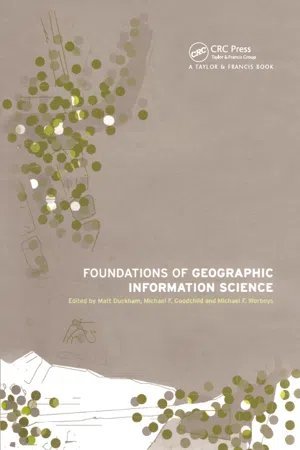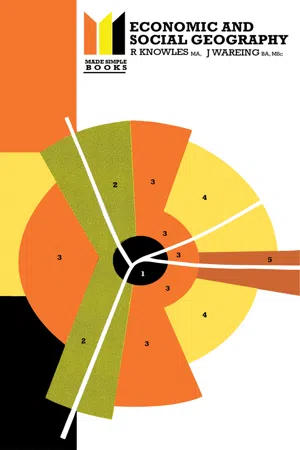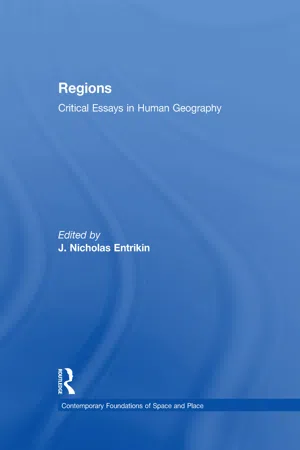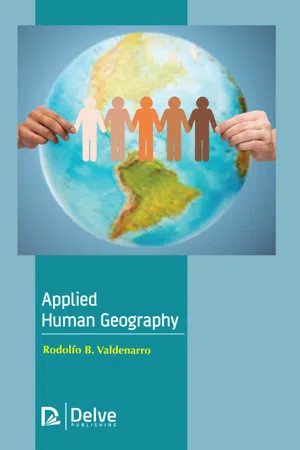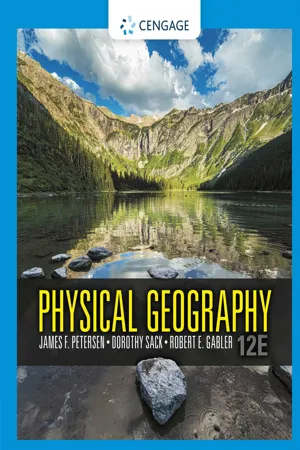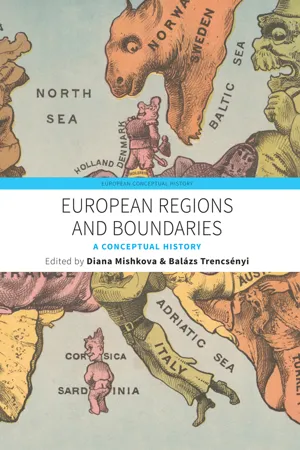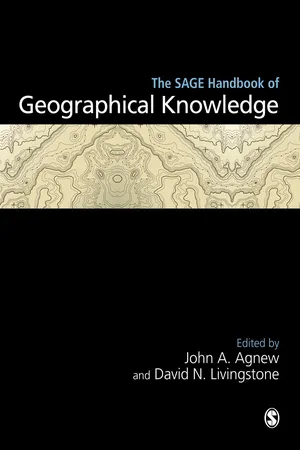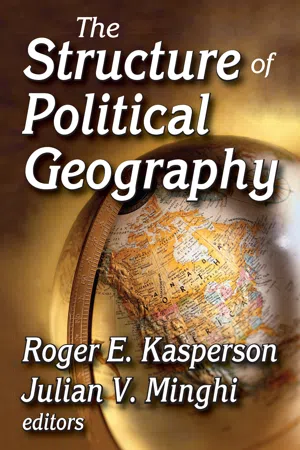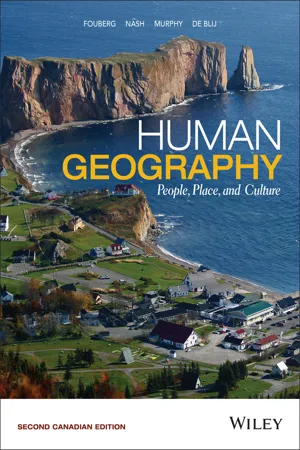Geography
Formal Regions
Formal regions are areas with defined boundaries and specific characteristics that set them apart from surrounding areas. These characteristics can be physical, cultural, or administrative in nature. Formal regions are often used in geography to study and analyze patterns and distributions of various phenomena within a specific area.
Written by Perlego with AI-assistance
Related key terms
1 of 5
11 Key excerpts on "Formal Regions"
- Matt Duckham, Michael F. Goodchild, Michael Worboys, Matt Duckham, Michael F. Goodchild, Michael Worboys(Authors)
- 2003(Publication Date)
- CRC Press(Publisher)
A formal region is defined as “distinguished by a uniformity of one or more characteristics” or “an area in which the selected trend or feature is present throughout.” Examples given include soil regions, dialect regions, topography regions, and often, political regions like Ecuador. This concept of Formal Regions, and its definitions, is problematic. Formal Regions include what I call thematic regions, but many writers also include as Formal Regions what I call administrative regions. In fact, thematic and administrative regions share very little conceptually. Administrative regions are an important and distinct type, and certainly deserve separate recognition. Failing to recognize administrative regions as a type is acceptable in a dehumanized earth science but not in geography. But setting aside the lack of recognition of administrative regions, what is meant by saying that climate or language regions are “uniform” or “homogeneous?” Even univariate thematic regions are rarely uniform throughout with respect to the relevant theme. Multivariate thematic regions are anything but uniform or homogeneous. The coastal sage-scrub ecosystem contains characteristic plants, rainfall, soil, and distance from the ocean to varying degrees across its extent. Furthermore, there is not complete agreement among experts as to what and how themes should be combined in order to define this ecosystem. The standard definition of Formal Regions in geography seems quite misleading. Again following Hartshorne, functional regions are “defined by the particular set of activities or interactions that occur within it” or “an area in which an activity has a focal point.” This is essentially the same functional region I include in my taxonomy. Definitions of functional regions frequently offer nodal region as a synonym. The idea here is that interaction emanates from a node, a point-like feature from which movement comes.- eBook - PDF
The World Today
Concepts and Regions in Geography
- Jan Nijman, Peter O. Muller, Harm J. de Blij(Authors)
- 2016(Publication Date)
- Wiley(Publisher)
This dominant uniformity makes it one of Russia’s natural and cultural regions, extending from the Ural Mountains in the west to the Pacific Ocean in the east. When regions display a measurable and often visible internal homogeneity, they are called Formal Regions 9 . But not all Formal Regions are visi- bly uniform. For instance, a region may be delimited by the area in which, say, 90 percent or more of the people speak a particular language. This cannot be seen in the landscape, but the region is a reality, and we can use that criterion to draw its boundaries accurately. It, too, is a formal region. • Regions as Systems Other regions are marked not by their inter- nal sameness but by their functional integration—that is, by the way they work. These regions are defined as spatial systems 10 and are formed by the areal extent of the activities that define them. Take the case of a large city with its surrounding zone of suburbs, urban-fringe countryside, satellite towns, and farms. The city supplies goods and services to this encircling zone, and it buys farm products and other commodities from it. The city is the heart, the core of this region, and we call the surrounding zone of interaction the city’s hinterland 11 . But the city’s influ- ence wanes along the outer periphery of that hinterland, and there lies the boundary of the functional region of which the city is the focus. A functional region 12 , therefore, is usually forged by a structured, urban-centered system of interaction. It has a core and a periphery. Interconnections Even if we can easily demarcate a particular region and even if its boundaries are sharp, that does not mean it is isolated from other parts of the realm or even the world. All human-geographic the physical setting 11 regions are more or less interconnected, being linked to other regions. As we shall see, globalization is forging ongoing integra- tion and connections among regions around the world. - Linda K. Rogers(Author)
- 1997(Publication Date)
- Libraries Unlimited(Publisher)
Chapter REGIONS u The basic unit of geographic study is the region, an area that displays unity in terms of selected criteria." —W. Kimball, K-6 Geography, 3 Regions exist only in our minds, that is to say, we determine their existence. We create regions with specific boundaries, such as countries or states within countries. We also create regions with indistinct boundaries, such as the Sahara Desert or the Great Plains. Our criteria may include physical features, ethnic distinctions, or language differ- ences. The same location may belong in several regions, depending on the criteria used to de- scribe it. For example, I currently live in north- eastern Pennsylvania, in Lackawanna County, in the Wyoming Valley, in anthracite coal country. In terms of ethnic and religious regional distinc- tions, it is a largely Roman Catholic region with many European cultures clustered throughout the valley. Although the largest percentage of the population claims either Italian or Irish ancestry, the Welsh community is the largest concentration outside of Wales. Geographers, in defining regions, first state the criteria, then draw the boundaries. They subdi- vide the theme into three areas: Uniform Regions, Functional Regions, and Cultural Diversity. Uniform Regions Uniform Regions are defined by some cultural or physical characteristic. These may include the product produced, as in the Wheat Belt; the common belief, as in the Bible Belt; or a political division, as with a coun- try, county, parish, or township. Functional Regions Functional Regions have a focal point and are the organized space around a central location. Examples in- clude metropolitan areas or market areas served by a par- ticular store or the district around a school. 75 76 Chapter 6: Regions Cultural Diversity Geographers remind us that understanding re- gions can lead to understanding Cultural Diversity.- eBook - PDF
- R. Knowles, J. Wareing(Authors)
- 2014(Publication Date)
- Made Simple(Publisher)
Fig. 3.3. Formal Regions of England and Wales (after J. F. Unstead). Fig. 3.4. Functional regions of England (after D. Senior). 30 Economic and Social Geography Made Simple region (Fig. 3.4). In a country such as the UK, where over 80 per cent of the population live in towns, this makes obvious sense, but even in less urbanised parts of the world, the influence of the city is increasing rapidly. A city region is the area around a city which is both served by the city, which provides shops, employment, professional services, etc., and in turn serves the city, by provid-ing food, water supply, labour and so on. The region thus operates as an integrated functioning whole, but it is very complex, and this complexity raises problems of measuring the extent of the city region (Chapter Twenty). In the attempt to divide up the surface of the earth into significant units, the search is for regions which first have a central unity, be it formal or functional, given by the interaction of the spatial and ecological systems, and secondly are clearly different from the regions around them. However, attempts to divide space into such regions have not been entirely successful and the concept of the region must be seen as an ideal or model rather than an objective reality. Two major problems arise from the attempt to make the regional ideal concrete. The first concerns the definition of regional boundaries. Even when defining Formal Regions, the boundary problem arises because features such as rainfall or vegetation do not change abruptly as lines on a map but rather shade from one region to another. Problems even arise over fixed features in the landscape such as mountain ranges or rivers, because although these may be barriers to movement and can therefore be considered as effective boun-daries, it can be argued with equal conviction that they give unity rather than separation in many regions. - eBook - ePub
Regions
Critical Essays in Human Geography
- J. Nicholas Entrikin(Author)
- 2017(Publication Date)
- Routledge(Publisher)
regionalization. The concept of region implicit in this starting point is “. . .a part of the earth’s surface which is distinguished in some defined way from the surrounding area” (see Grigg 1968: 464, cf. Harvey 1969: 125, James 1972: 460). Consequently the concept of region which forms the basis for classification does not necessarily differ essentially from that involved in chorological thought performed by the representatives of regional geography.An analysis of the definitions given of the geographical concept of region shows that the essence of regions is commonly discussed from the same point of view. Hence crucial problems (in connection with regional geography) have been the nature of geographical description and its constitution (from rock and soil to human ideologies) and as far as geography’s basic categories are concerned, the nature of the concept of region, i.e. the logical (conceptual) meanings of a region. Discussions of the latter have usually been restricted to formal or functional regions and to their roles as means of classification. Although the relationship between geography and history has always been an interesting question in the methodology of the institutionalized discipline of geography, this fact has not manifested itself in the definitions of geographical regions. As seen above, not only methodologists but also historical geographers have laid stress on the role of the historical perspective in geography, but this state of affairs has not been reflected in the definitions of region. If one considers that a dictionary of a discipline can be analysed as an indicator of the development of the conceptual basis of the subject, Derek Gregory (1981a: 283–284) may be said to introduce into “Dictionary of Human Geography” only the traditional ideas of region, even though, as a methodologist of human and historical geography, he has been interested in regional transformation - eBook - PDF
- Rodolfo B. Valdenarro(Author)
- 2019(Publication Date)
- Delve Publishing(Publisher)
• Landforms are the natural shapes on the Earth’s surface. For example, hills, valleys and mountains. • There are human characteristics such as language, ethnicity, political and economic systems, standards of living, religion and population distribution. • A region can be defined as an area having common characteristics which make it different from other surrounding areas. • There are one or more than one shared characteristic in a formal region such as plant life, it can be cultural, economic or political. Some other examples of the formal political regions are the countries, states and cities. • A functional region contains a number of different places that function together as a unit. For example, a metropolitan area. • Perceptual regions can be defined by the shared attitudes, culture and feelings about an area of the people. 1.6.3. Physical Systems • There are four physical systems that contains the physical processes and interactions which are studied by the geographers named as atmosphere, land, water and life on Earth. • There are physical processes which shape and change the physical features and environments of the Earth. • Climate as well as weather both affect humans. • An ecosystem can be defined as all of the area’s plants and animals together along with the non-living parts of their environment. Among all, Earth is the largest ecosystem. • Natural events and human activity have the tendency to change the ecosystem. • It is required to study the physical processes and ecosystems because the environment is important for all life on Earth. Applied Human Geography 20 Figure 1.6: Physical system. Source: https://commons.wikimedia.org/wiki/File:Physical_systems-en.svg 1.6.4. Human Systems • It is required to study the human systems. For example, population distribution, movement and growth. This will help in better understanding human events and geography. - eBook - PDF
- James Petersen, Dorothy Sack, Robert Gabler, , James Petersen, James Petersen, Dorothy Sack, Robert Gabler(Authors)
- 2021(Publication Date)
- Cengage Learning EMEA(Publisher)
Geography emphasizes how physical and cultural attributes vary from place to place, how places and features change over time, and the processes and interactions responsible for these variations. Geographers gather, organize, and analyze many kinds of data and information in seeking to explain locations, areas, pat- terns, distributions, and relationships over the surface of Earth. Many individual geographers, whether physical or human, solve problems or answer questions at the local or regional scale, rather than considering the entire planet at once. As a result, geographers are interested in defining meaningful regions, which are areas identified by distinctive characteristics that dis- tinguish them from surrounding areas. The distinctive charac- teristics used to define a region can be physical, human, or a combination of factors, and a given location can belong to vari- ous types and sizes of regions depending on the criteria used and purposes for identifying the regions. Regional geography empha- sizes the study of the characteristics of a region or of multiple regions. 1-2 Geographic Technology Rapid advances over the past four decades in global posi- tioning systems (GPS), communication, and information science technologies have greatly enhanced our ability to learn about Earth’s physical geography. We locate points on Earth’s surface quickly, easily, and accurately; measure attri- butes of those ground points more precisely; and gather, manipulate, and share larger data sets than ever before. We obtain much data about Earth’s surface remotely, such as from sophisticated instruments and sensors carried on board satellites and aircraft, including remotely controlled aerial vehicles, which are commonly called drones. Some data col- lection, however, also requires in-person fieldwork, often with the aid of specialized instruments, and fieldwork will probably always play an important role in physical geography (● Fig. 1.3). - eBook - PDF
European Regions and Boundaries
A Conceptual History
- Diana Mishkova, Balázs Trencsényi, Diana Mishkova, Balázs Trencsényi(Authors)
- 2017(Publication Date)
- Berghahn Books(Publisher)
Chapter 12 Political Geography and Geopolitics Virginie Mamadouh and Martin Müller Geography is sometimes conceived as a regional science, a discipline special-ized in the study of the specificities of regions. When introducing geography to students, it is customary to highlight two different approaches to geog-raphy—regional geography versus thematic geography—and to conceptual-ize their relations as follows. Thematic geography consists of a wide array of subdisciplines focusing on the geographical (meaning spatial, territorial, and/or scalar) dimensions of a social, behavioral, or physical aspect. Political geography, for example, studies the geographical dimensions of the political. Regional geography, by contrast, has a regional focus and synthesizes knowledge and insights from many thematic perspectives in the study of a specific region. Regions can be small or large, and a great deal of geographical theorizing has been done to develop and enhance our conceptualization of regions and their delimitation. Some definitions are based on one dimension, such as a linguistic region as the area in which a common language is spoken, distinct from the languages spoken in the neighboring regions, or a region defined by a distinct landscape, different from the landscapes in the neighbor-ing regions. Others are functional, such as the service area of a market town. Some are administrative, as in the case of a territory under the jurisdiction of a specific authority such as a municipality, a province, or a state, whereas others are defined on the basis of the combinations of different physical, eco-nomic, cultural, and other dimensions. As far as political geography is concerned, regions are important as politi-cal constructs, as arenas of political engagement, and as terrains of the projec-tion of power. Regional identities are mobilized at different scales and provide - eBook - PDF
- John A Agnew, David N Livingstone, John A Agnew, David N Livingstone, SAGE Publications Ltd(Authors)
- 2011(Publication Date)
- SAGE Publications Ltd(Publisher)
For many geo-graphers the region has limited scientific standing, primarily as a means of areal cate-gorization or classification that uses criteria of both similarity and difference for simulta-neously distinguishing one areal unit from another and making continuous variation discrete by imposing a set areal of units. Geographers have used a variety of criteria to make such discriminations, ranging across natural and social characteristics, from allu-vial processes and climate to economy and religion. Areal differentiation as classification gen-erated one form of region, the generic. The more challenging goal, however, was to comprehend and represent the particular or specific region, a distinctive area, the characteristics of which differentiated it from other areas and created some sense of bounded areal wholeness. It is this form of chorological analysis that demanded the form of difficult synthesis described above by H.C. Darby. Not all geographers shared Darby’s rather dim view of synthesis, but most recognized the difficult challenges that it posed (e.g. see Harris 1971). For scientific critics of chorology, this form of synthesis was unacceptably subjective in that there were no acceptable standards of judgment of either significance or selection (Entrikin 1983). For supporters of regional geography, such criticisms were irrelevant. For example, John Fraser Hart (1982) maintained that regional geography was a distinctive intel-lectual exercise that was neither science nor art. For Hart, the position in-between is what makes geography distinctive and allows it to best fulfill its intellectual promise and social responsibility. German geographers and their American interpreters offered the methodological sup-port for regional geography. French geogra-phers, however, most notably the school of thought associated with Paul Vidal de la Blache, were the celebrated practitioners. - eBook - ePub
- Julian Minghi(Author)
- 2017(Publication Date)
- Routledge(Publisher)
38 This general interest in boundaries as regional divides has provided concepts often applicable to political geography, as we shall see below.The utility of boundaries in studying problems of political integration and disintegration and of transfer of sovereignty will be discussed in the following Part (Process).Some Misleading Notions
The “natural-is-good” and “artificial-is-bad” concepts are based on the assumption that the degree to which a political boundary conforms to a natural feature is the measure of its success as a political divide. In other words, boundaries “established in an unrealistic manner tend to create problems commensurate to the degree with which they defy the forces of nature.” 39 Although many political boundaries are based on physical landscape features, they are all by definition political and therefore, whether naturally based or not, are man-made, hence artificial. It follows that a boundary’s “goodness” or degree of success is more a function of its role as perceived by members of the political systems it divides rather than of the environmental character of the line itself.Another widely held notion, somewhat associated with the above idea, still enjoys currency and even official authenticity. This holds that boundaries are the “enemies” of geography because they “conflict” with the operation of “geographical principles,” and hence social patterns are “compartmentalized” by these “unnatural” restrictions.40 The notion that “it is unfortunate when society must accommodate itself to boundaries rather than boundaries to society” is a logical corollary to this line of thought.41 - eBook - PDF
Human Geography
People, Place, and Culture
- Erin H. Fouberg, Alexander B. Nash, Alexander B. Murphy, Harm J. de Blij(Authors)
- 2015(Publication Date)
- Wiley(Publisher)
These contradictions, and many more, are the focus of political geographers as they engage in the study of boundaries, borders, and borderlands. NATIONS The popular media and press often use the words “nation,” “state,” and “country” inter- changeably. Political geogra- phers use “state” and “country” interchangeably (often prefer- ring “state”), but the word “nation” is distinct. “State” is a legal term in international law, and the international political community has some agreement about what this term means. “Nation,” on the other hand, is a culturally defined term, and few people agree on exactly what it means. Definitions are important as few words are as politically charged as the concept of nation. The Dictionary of Human Geography (4th edition) defines a nation as a community of people whose members are bound together by a sense of solidarity rooted in an historic attachment to a homeland and a common culture, and by a sense of con- sciousness of being define from other nations. (p. 532) definitions. Boundaries can be defined as physical or imagi- nary lines of contact between states, including the institu- tions and symbols that exist and are reproduced in social practices and discourses. Borders are understood as the adjacent areas lining boundar- ies. Borderlands are the transition zones within which a boundary (line) is located. Finally, a frontier is a category that usually refers to political divisions (zones) between states or to divisions between settled and uninhabited areas within a state. Since the 1980s, we have witnessed tremendous changes to the borders and boundaries that shape the modern world, such as the taking down of the Berlin Wall (1989) (Figure 3.13), the collapse of the former Soviet Union (1991), the formation of the European Union (1993), the signing of the North American Free Trade Agreement (1993), and the myriad terrorism-related security concerns after 9/11 (2001).
Index pages curate the most relevant extracts from our library of academic textbooks. They’ve been created using an in-house natural language model (NLM), each adding context and meaning to key research topics.
